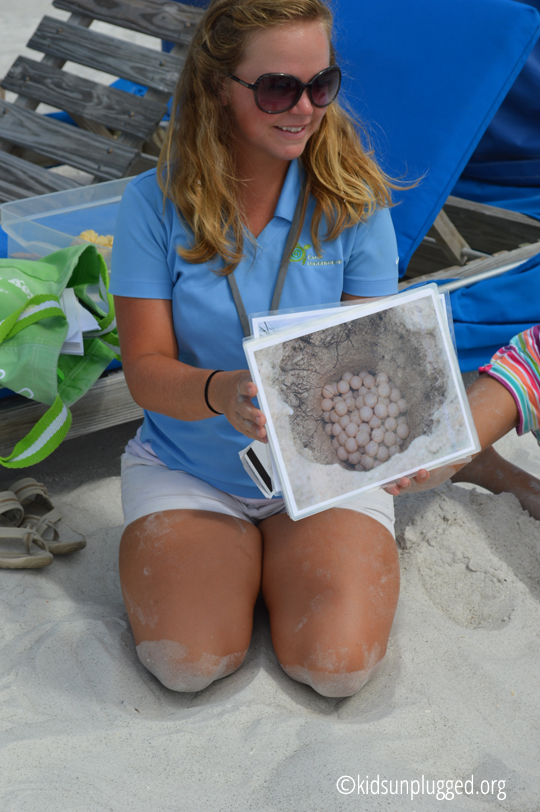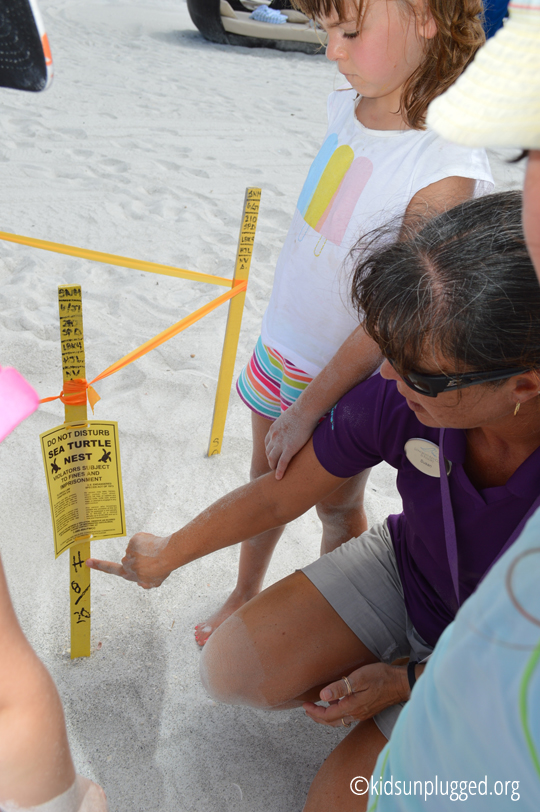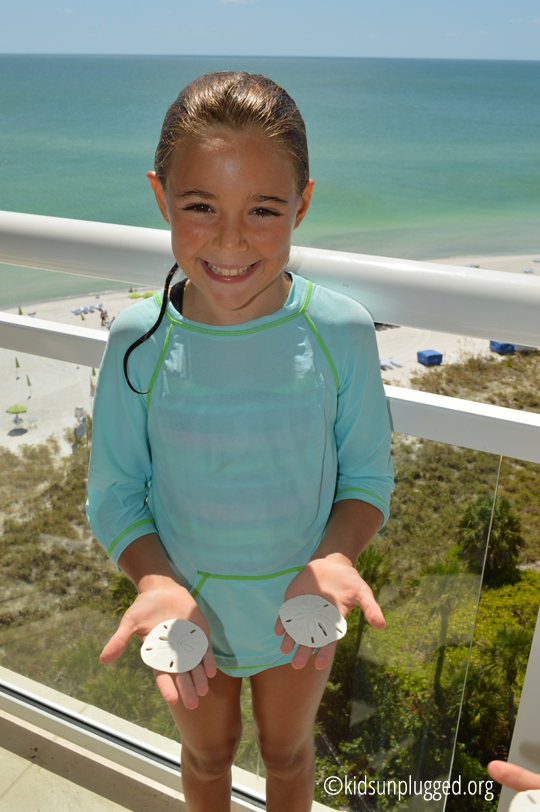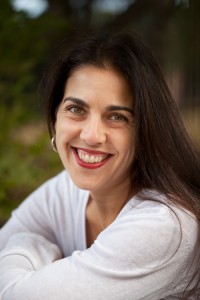As with many of the beaches along the Florida coasts, the stretch of white sand at the glorious Longboat Key Club is a seasonal nesting spot for endangered loggerhead sea turtles. It seems that we’re having a week of sea turtle education as before our arrival at Longboat Key we spent a few days at the Kiawah Island Resort in South Carolina whose 10-miles of beach was dotted with about 100 turtle nests. Our sea turtle experience would continue on Longboat Key where the girls and I spent an enriching hour with Sue Geeslin, Activities Coordinator at the resort’s Camp Loggerhead, learning all about the egg laying, nesting habits, survival, and protection of these threatened creatures.

We met Sue by chance early that morning when we were out for a stroll on the beach, excited to see what shells we might find before the rest of the beachcombers arrived. Sue was making her regular rounds, checking the protected turtle nests and gathering bits of trash that washed ashore. Sue spotted the girls and I, immediately asked if we were guests at the resort, and invited the girls to join her for some fun activities that day. Our meeting was fortuitous as we’d already planned on some time at Camp Loggerhead for that day. We arranged to meet Sue and her colleague Andrea later that morning for an impromptu turtle talk and went off to have breakfast.
Camp Loggerhead is the children’s club and activity center at the Longboat Key Club Resort that offers a wide variety of programming for resort guests ages 5-12. The counselors are patient, engaging and skilled and have created a series of educational events that include crafts, nature walks, water play, field trips and evening parties. Parents can choose to enroll their kids in anything from a morning of swimming and sand-sculputure to a weeks’ worth of on and off-site adventures.

After breakfast we joined Sue and Andrea on the Resort’s gorgeous beach along with a few other kids who would be participating. Sue began the program talking a little bit about the ecology of the beach and about some of the interesting things the kids might find on the shore or in the sparkling, aquamarine Gulf of Mexico. She had a container full of some of these items and the kids had the chance to guess what each one might be and to hold and study it on their own. The kids did well at identifying things like skate and horseshoe crab egg sacks, various types of seashells, and sand dollars. Sue emphasized the importance of never removing any living creatures from the water or shoreline but assured the kids that if they collected beach treasures that were well-dried in the hot, white sand that they were fine to keep.
 The talk then moved on to the all-important sea turtle and Andrea and Sue showed the kids images of what the female turtles look like when they are preparing their nests. The little ones got into the action by moving their own “flippers” in a circular motion as they imitated the nest-making behavior of the mother turtle. My 12-year old daughter was rather amused and opted not to make a nest of her own.
The talk then moved on to the all-important sea turtle and Andrea and Sue showed the kids images of what the female turtles look like when they are preparing their nests. The little ones got into the action by moving their own “flippers” in a circular motion as they imitated the nest-making behavior of the mother turtle. My 12-year old daughter was rather amused and opted not to make a nest of her own.
Sue told the kids all about the challenges nesting mothers and loggerhead hatchlings face. Artificial light from nearby buildings can confuse both the egg-laying mothers and the newly hatched babies. In order to keep from interfering with the natural process of nesting and hatching, resort rooms all have heavy curtains on their Gulf-facing windows to block the light from reaching the beach. Guests are encouraged to keep these closed during nesting season (May through October) as light can discourage a nesting female from laying her 100-plus pingpong ball sized eggs. Lights are equally, if not more harmful for hatchlings who use the light of the moon to direct them from their nests to the ocean after hatching and artificial light can cause them to become disoriented in their quest for the water. Additionally, the resort is diligent about removing beach chairs and other similar items each evening as these can act as barriers to both a female who is heading up the beach to dig her nest as well as to the hatchlings as they begin their migration back to the ocean.
As we walked along the beach to investigate a turtle nest, we learned about the ways that the nearby Mote Aquarium’s Sea Turtle Patrol is able to read an adult turtle’s tracks to determine the location of a nest. Sue also explained how scientists use the tracks of the hatchlings to estimate the number of babies that may have successfully made it back into the Gulf.
When the session ended, Andrea gave each of the kids a very neat sea turtle activity book. My hot and sweaty girls made a beeline for the sea, moving their feet along the soft sand in a manner called the “stingray shuffle,” a motion meant to warn rays resting below of one’s approach–something else we learned that morning. We spent the rest of the day floating in the warm water, searching for some of the shell’s Sue showed us that morning and building drippy castles along the shore. Another perfect, unplugged afternoon at the beach.
And a special thanks to Sue for the thoughtful gift of sand dollars for the girls–they absolutely love them!

Disclosure – We received discounted rates and complimentary meals and activities during our stay at the Longboat Key Club. As always, all opinions in this post are my own.


What a wonderful surprise to open up this morning! Thanks so much for those beautiful words that you used to describe our program at Camp Loggerhead – I can actually feel the passion of what I’m trying to teach our future adults and stewards of our environment, in your words! Have a wonderful fall upcoming holiday season, hope we can spend some time together again! Sue
Good Morning, Sue! So glad you enjoyed the piece. The girls and I truly enjoyed the time we spent with you and Andrea and hope that more folks will have the opportunity to take advantage of all the fantastic programming that you guys are offering guests at Longboat Key Club. I’ll be sure to spread the word as best as I can. And we, too, hope to get down there again! Warmly, Gina